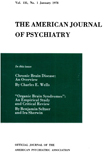THE SYMPTOMATIC ADOLESCENT: PSYCHIATRIC ILLNESS OR ADOLESCENT TURMOIL?
Abstract
This paper details a method of selecting a group of relatively healthy adolescents, describes their characteristics and compares them with adolescents who are psychiatrically ill.
Using the traditional psychiatric concept of health, i.e., freedom from significant symptoms and impairment of functioning, we selected relatively healthy (R.H.) and psychiatrically ill (P.I.) adolescents by clinical review of two larger groups. The latter included 101 patients, ages 12-18, and 101 controls matched to the patients for six criteria and selected by random sampling. We selected a P.I. group of 93 and an R.H. group of 41. Although the latter had some symptomatology it was subclinical and did not impair functioning.
Systematic data are presented to highlight the marked differences between the two groups in symptomatology, functioning, demographic factors and family relationships.
The relatively healthy adolescents, although they may be in turmoil, did not show symptoms that simulate a psychiatric illness and differed quite distinguishably from those with a psychiatric illness. This suggests that adolescent symptomatology may not be as confusing as theory implies and that it may be more possible than previously thought to identify psychiatric illness in adolescence.
Access content
To read the fulltext, please use one of the options below to sign in or purchase access.- Personal login
- Institutional Login
- Sign in via OpenAthens
- Register for access
-
Please login/register if you wish to pair your device and check access availability.
Not a subscriber?
PsychiatryOnline subscription options offer access to the DSM-5 library, books, journals, CME, and patient resources. This all-in-one virtual library provides psychiatrists and mental health professionals with key resources for diagnosis, treatment, research, and professional development.
Need more help? PsychiatryOnline Customer Service may be reached by emailing [email protected] or by calling 800-368-5777 (in the U.S.) or 703-907-7322 (outside the U.S.).



